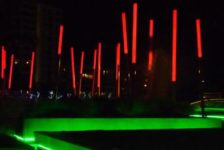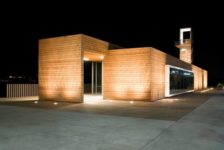Sure we have all seen sculptures in art galleries that can stand the test of time. They vary in sizes, materials and like all art; they represent a certain meaning… the imagination of the artist that he or she has brought to life. What about art that can move through the test of time? Kinetic art is a three-dimensional sculpture work that has motion and expands into the world of The Art and Science of Wind Propelled Sculptures. Like the examples you will see in a short while, they have the ability to move through forces of nature such as wind, solar power, gravity or magnetism. The word motion is the key word here. Movement is a part of our daily lives; We are in motion for most parts of our day that it becomes a series of actions that go unnoticed. “Just as one can compose colors or forms, so one can compose motions.” – Alexander Calder Kinetic artists create to explore the science behind these motions and make the viewers appreciate the joy in motion. If you explore the process of these magnificent pieces, you will find that, many times, the initial step of imagining takes on the process of scientific theories, mathematical calculations and even working on computer software to finally bring it to life. Therefore it is apparent that to the kinetic artists, expressing movement becomes a critical element of the sculpture. Like a painter using colors to explore their form of expression, motion becomes a propelling tool of self-expression for kinetic artists, much like a dancer. Let’s go back through time and see how this tool of self-expression has developed over time to present day, where new technology and art in demand allow for artists to push the boundaries with a new palette of creations. 1913: Marcel Duchamp’s Bicycle Wheel: Marcel Duchamp was the pioneer of the kinetic art form. This piece of sculpture that consisted of a bicycle wheel attached to a stool started to question the possibilities of sculpture art. It was seen as a piece of kinetic art as the wheel could be spun. 1941:Alexander Calder’s Arc of Petals: This kinetic art is a hanging sculpture that uses natural organic forms. The careful balancing of materials and composition, with the larger heavier forms on top and lighter ones at the bottom, allow for gentle motions in light breezes. The work is suggestive of autumn leaves that fall to the ground at the sight indication of breeze. 1964: Bridget Riley’s Blaze: Another form of kinetic art was explored during the 1960s. This type of kinetic art uses perceptual optical illusions. Marcel Duchamp’s Bicycle may have well been the inspiration behind Bridget Riley’s Blaze. When the viewers look at this, they are given the impression of movement within the piece. At times, they themselves have to move backwards and forward in order to be able to ‘see’ the motion. 1990s-present day: Theo Jansen’s Strandbeest: These sculptures embody a life of their own and are bound to make us stop and wonder about our own movement patterns. Made of light plastic yellow tubes, these “new forms of life”, as described by Jansen, are powered only by the wind. With strong and slightly futuristic visions, Jansen almost makes the viewers, who encounter these creatures, wonder how these kinetic art forms can become a part of our society. Reuben Margolin’s Nebula: Made from 445 suspending cables and 15,000 shimmering bicycle reflectors, and coming to life through a series of mathematics equations combined with technology, this gigantic piece of kinetic art shows the motion of waves with a peaceful quality. The process behind the creation just goes to show how these kinetic art forms can be just as complicated as they can be simple. Kinetic Rain in Changi Airport, Singapore: The cooperation between artists, programmers and technologists made this a truly mesmerizing piece of art in motion. Kinetic Rain represents Singapore’s tropical climate. Each droplet changes in motion- at times moving in unity and other times by their own rhythm. Here, the notion of motion is represented very delicately that it almost seems musical. Behnaz Babazadeh’s Fermid: Fermid depicts the natural movement that can be found in living organisms. What’s unique about this piece is that it incorporates lighting and realistic and sensitive motions to challenge the viewer’s “perception of body and space” as explained by Babazadeh. The sculpture successfully imitates the natural motions; the mechanical breathing movement is almost life-like. Fermid seems to have a life of its own and may just as well be a living form lurking under the sea, inhaling and exhaling…sitting and waiting… Fermid from Behnaz Babazadeh on Vimeo. The examples above show just how one idea of an art form, first initiated by one, can be explored and expressed through different mediums by many other artists. Kinetic art over time has been given multiple dimensions. It is also a great example of what can be achieved when multiple professions join to express creativity at a bigger and innovative scale. As technology becomes more advanced, the notion of motion through art is sure to be amplified and expressed further creatively in the future days to come. Article written by Win Phyo Featured image: shutterstock.com
This article was originally submitted to Landscape Architects Network
Published in Blog









